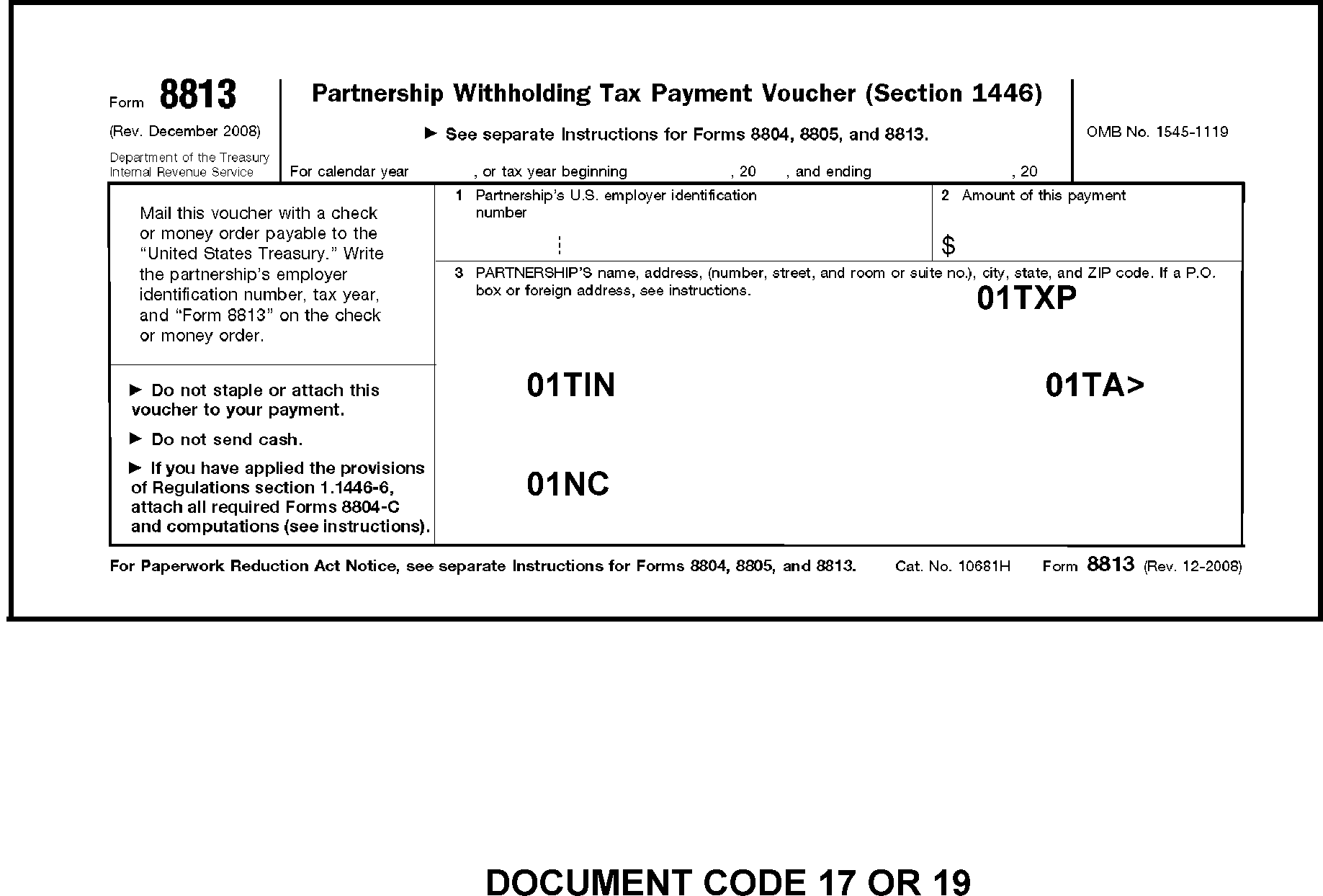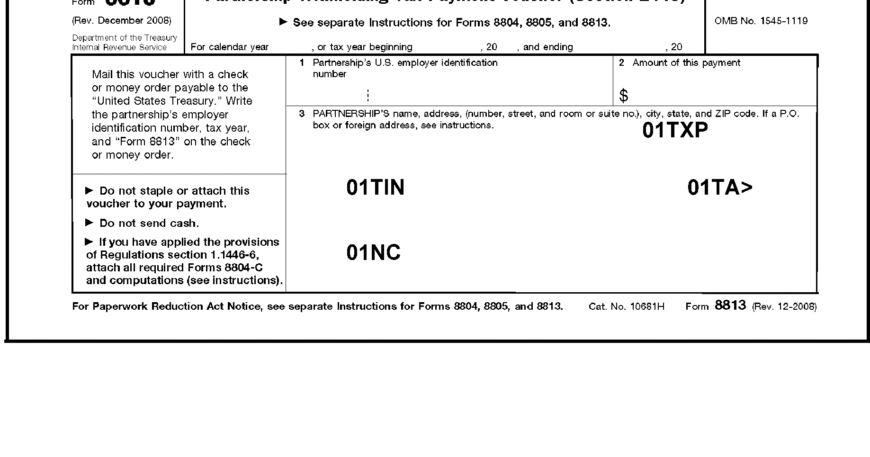7 Surprising Benefits & 5 Critical Drawbacks of Form 8813 You Need to Know
When operating a partnership that has foreign partners or foreign source income connected to a U.S. trade or business, knowing 8813 is essential. But like any tax form, 8813 comes with advantages and risks. In this comprehensive guide (≈ 2,000 words), we’ll dive deep into 8813 — what it is, when and how to file, its benefits, pitfalls, and best practices for avoiding mistakes.
We’ll use Form 8813 frequently (20–30 times) so that by the end you’ll be intimately familiar with it.
What Is Form 8813?
8813, officially titled “Partnership Withholding Tax Payment Voucher (Section 1446)”, is a payment voucher used by partnerships to pay withholding tax under IRC Section 1446.
Essentially, when a partnership has income that is “effectively connected” with a U.S. trade or business and that income is allocable to foreign partners, the partnership is required to withhold tax on that portion. 8813 is the mechanism through which the partnership remits that withheld tax to the U.S. Treasury.
Each time the partnership makes a withholding tax payment during its tax year, it must accompany that payment with 8813.
When & How Often Must You File Form 8813?
One of the essential features (and occasional frustrations) of 8813 is its periodic filing frequency. The IRS requires that 8813 be filed on or before the 15th day of the 4th, 6th, 9th, and 12th months of the partnership’s tax year.
Thus, you are not just filing it once annually—you must file it quarterly in those specific months, matching the payments you make toward withholding tax.
If the partnership uses the Electronic Federal Tax Payment System (EFTPS) to transmit the withheld amounts, 8813 still must accompany the payments, or the filing obligations must still be met.
Missing the deadlines for 8813 payments or filings can expose the partnership to penalties and interest, so understanding the timeline is critical.
Who Must Use Form 8813?
Not every partnership needs to worry about 8813. It is specifically required when the partnership has effectively connected taxable income (ECTI) that is allocable to foreign partners under IRC Section 1446.
If your partnership has no foreign partners, or your partnership income is not “effectively connected” to a U.S. trade or business, then 8813 likely does not apply.
Additionally, publicly traded partnerships may have a slightly different treatment: some must withhold on distributions rather than use Forms 8804 / 8813, depending on elections made. I
If your partnership is subject to Section 1446 withholding, 8813 is mandatory for remitting those periodic payments.
What Information Is Included in Form 8813?
Filling out 8813 requires certain specific pieces of information:
-
Partnership’s U.S. Employer Identification Number (EIN). You must include the partnership’s EIN. If you’ve applied but not yet received the EIN, you may note that on the form.
-
Amount of this payment. The dollar amount of the withholding tax being remitted at that time.
-
Partnership’s name, address, city, state, ZIP code. Standard identifying information.
-
Tax year information. You may need to specify the tax year or tax period for which the payment applies.
-
Attach required computations or forms, if applicable. If the partnership uses certain elections or must apply regulations under section 1.1446-6, you may need to attach the computations or additional forms (e.g., Forms 8804-C).
The form is a relatively simple voucher, but accuracy is crucial: errors in EIN, amount, or failing to attach required supporting schedules can cause processing delays or misapplication of payments.

7 Surprising Benefits of 8813
Despite being a “payment voucher,” Form 8813 offers several important benefits that may surprise many:
1. Procedural Compliance & Avoidance of Penalties
Using Form 8813 ensures that the partnership remains compliant with the IRS’s withholding requirements under Section 1446. Without properly filing 8813 with each payment, the partnership may trigger penalties or interest.
2. Clear Audit Trail
Each 8813 voucher creates a formal record of the withholding payment attached to that period. This can be invaluable in audits or when reconciling records with foreign partners.
3. Predictable Withholding Schedule
Because 8813 must be filed quarterly, it forces the partnership to maintain a predictable schedule for withholding payments, improving cash flow planning and reducing last-minute scrambling.
4. Integration with Forms 8804 / 8805
8813 dovetails with the annual filing of Form 8804 (the partnership’s overall withholding return) and the issuance of Form 8805 (to foreign partners). The systematic use of 8813 makes it simpler to aggregate and reconcile withholding amounts.
5. Supports Elective Adjustments
When a partnership elects to apply certain regulatory provisions under section 1.1446-6, 8813 allows attaching the supporting computations, making it smoother to implement more advanced strategies.
6. Crediting Foreign Partners’ Returns
Because the withholding payments remitted via 8813 are tied to foreign partners’ shares, those partners can claim credits on their U.S. tax returns (or partner returns) using Form 8805, which is connected to 8813 payments.
7. Encourages Discipline & Accuracy
Because 8813 must be regularly filed and correctly completed, it encourages the partnership and its tax team to maintain up-to-date and accurate records, reducing the risk of costly errors down the line.
5 Critical Drawbacks & Pitfalls of 8813
However, 8813 is not without challenges. Here are some of the important drawbacks to watch out for:
1. Complexity & Risk of Mistakes
Although its layout is simple, errors in 8813 are common—incorrect EINs, wrong payment amounts, mis-dated periods, or missing attachments can all lead to processing delays or misapplication of payments.
2. Strict Deadlines
Missing any of the quarterly deadlines for 8813 payments can trigger interest or penalties on the withheld tax. The rigid schedule might be burdensome for smaller partnerships without robust tax infrastructure.
3. Cumulative Burden
Because 8813 must be filed each quarter, the administrative burden accumulates. Especially for partnerships with minimal foreign partner allocations, the repeated filings may feel onerous.
4. No Electronic Submission Directly
While the cash or check payments may be made via EFTPS, Form 8813 itself must accompany the payment or meet filing obligations. The IRS does not currently accept Form 8813 itself as an independent electronic form.
5. Additional Attachments for Elections
If the partnership adopts elections or special regulatory computations (e.g., under section 1.1446-6), those supporting forms or computations must be attached to Form 8813. Failing to do so can lead to rejection or adjustments.
These drawbacks suggest that while Form 8813 is necessary, it must be handled with care and oversight.
Step-by-Step: How to Fill Out Form 8813 (with Tips)
Below is a walkthrough to complete Form 8813 correctly and efficiently.
1. Gather Required Data
-
Partnership EIN
-
Tax year or period
-
Total withholding tax amount for that period
-
Partnership name and address
-
Any supporting calculations or elections (if applicable)
2. Fill in Basic Fields
-
Line 1: Partnership’s U.S. EIN
-
Line 2: Amount of this payment
-
Line 3: Partnership name, address, city, state, ZIP code
-
Indicate the tax year period
Ensure accuracy—double-check the EIN and amount before proceeding.
3. Attach Supporting Schedules (If Required)
If your partnership made any elections (per section 1.1446-6) or needs to show the computations for partner-level deductions, attach those documents. Omitting them could delay processing.
4. Prepare the Payment
Prepare a check or money order payable to “United States Treasury” (in U.S. dollars). On the check, write the partnership’s EIN, tax year, and “Form 8813.” Do not staple or attach the voucher (Form 8813) to the payment.
5. Submit on Time
Mail the voucher and payment so it reaches the IRS by the 15th of the 4th, 6th, 9th, or 12th month of your partnership’s tax year (as applicable).
If you’re using EFTPS, transmit the payment electronically but still ensure the Form 8813 or equivalent voucher obligations are met.
6. Maintain Records
Retain copies of Form 8813, the payment proof, and supporting documentation. This is critical for audit defense and to reconcile with annual filings like Form 8804 and Form 8805.
Common Mistakes & How to Avoid Them
Even seasoned tax professionals sometimes slip up with Form 8813. Below are common pitfalls and strategies to avoid them:
| Mistake | Consequence | Prevention Tip |
|---|---|---|
| Incorrect EIN | Payment may not be credited correctly | Always verify the EIN with internal records |
| Wrong amount | Underpayment or overpayment | Cross-check against partnership withholding schedule |
| Missing supporting attachments | IRS may reject or adjust payment | Keep a checklist for attachments for elections |
| Late filing/payment | Penalties & interest | Set internal reminders well ahead of deadlines |
| Stapling voucher to payment | IRS instructs not to staple | Use separate enclosures and packaging |
| Omitting reference on check | Check may not link to correct Form 8813 | Write “Form 8813,” EIN, and tax year on payment |
By proactively guarding against these errors, your partnership will reduce delays and administrative headaches.
How Form 8813 Fits Into the Larger Section 1446 Withholding Scheme
To truly understand Form 8813, you need to see how it fits into the broader landscape of Section 1446 withholding:
-
Partnership generates income that is effectively connected to a U.S. trade or business.
-
Allocate income to foreign partners — that share becomes subject to Section 1446 withholding.
-
Partnership computes and withholds the required tax amount (often at highest applicable rates for foreign individuals or corporations).
-
Remit payment via Form 8813 periodically during the tax year (quarterly).
-
At year end, file Form 8804 (annual return) attaching Forms 8805 (to partners) that detail each foreign partner’s share and credit ability.
-
Foreign partners use Form 8805 credits when filing their U.S. returns (or other required returns).
Thus, Form 8813 is not standalone—it is one cog in the withholding, remittance, and reporting machinery mandated by Section 1446.
Example Scenario: Using Form 8813 in Practice
Let’s walk through a simplified example illustrating how Form 8813 might work in a small partnership.
Scenario
XYZ Partnership has a tax year beginning on January 1 and ending December 31. The partnership has two foreign partners receiving allocations of effectively connected income subject to withholding.
During the year, quarterly calculations show that the partnership must withhold $50,000, $70,000, $60,000, and $80,000 in each respective quarter.
Application of Form 8813
-
In April, the partnership fills out Form 8813 (first quarter) for $50,000, pays it by April 15, and mails the voucher + payment.
-
In June, it uses another Form 8813 for $70,000, and again meets the 15th-of-month deadline.
-
In September, a third Form 8813 for $60,000.
-
In December, a final Form 8813 for $80,000.
-
At the end of the year, the partnership files Form 8804, attaching Forms 8805 that break down each foreign partner’s share and withholding credit.
This consistent use of Form 8813 helps maintain compliance, avoids large lump-sum burdens at year end, and ensures proper tracking.
Best Practices & Pro Tips for Form 8813
To get the most out of Form 8813 and reduce risk, consider these best practices:
-
Set up internal reminders well in advance of each 15th deadline to prepare Form 8813
-
Use a centralized ledger/accounting system for partnership withholding allocations
-
Pre-verify EIN and partner data before filling out Form 8813
-
Maintain a checklist for required attachments, especially if using regulatory elections
-
Use EFTPS where possible, but double-check Form 8813 obligations still apply.
-
Archive copies of each Form 8813, payment receipts, and reconciliation notes
-
Coordinate early with partner return preparation so that Form 8813/8805/8804 align
-
Consult tax counsel or a professional if your partnership’s structure or foreign partner composition is complex
Final Thoughts: Is Form 8813 Worth the Effort?
The bottom line is: Form 8813 is not optional if your partnership is subject to Section 1446 withholding. It is mission-critical for compliance. But just because it’s mandatory doesn’t mean you should treat it as an afterthought.
Pros (benefits) of Form 8813 include compliance assurance, audit trail, integration with annual filings, and prompting better recordkeeping. Its drawbacks revolve around stringent deadlines, repetitive administration, risk of errors, and the need for precise supporting attachments.
If your partnership handles Form 8813 proactively, with structured processes and timely preparation, the risks can be minimized and the benefits maximized.




